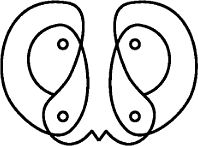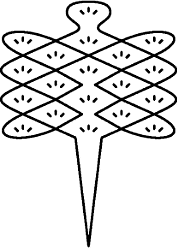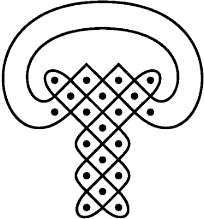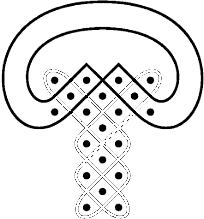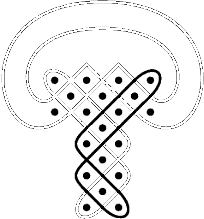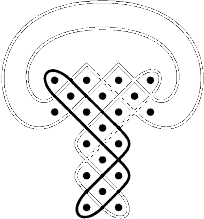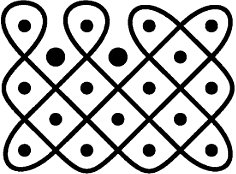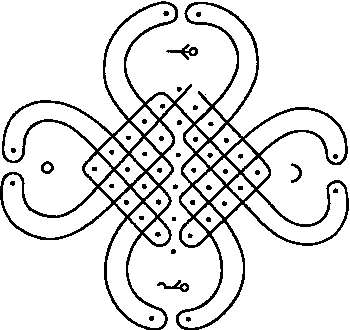INTRODUCTION
During the 15th century, a Lunda Queen married a Luba Prince called Tshibinda Ilunga.
A significant number of the Lunda aristocracy so disapproved of the marriage that they migrated south. Once settled, they founded several Kingdoms, each headed by a god-king. Amongst these tribes are the now known Tchokwe. Around 1860, following a major famine, the Tchokwe people migrated back towards the south and settled at the source of the Kwango, Kasai and Lungwe rivers.
The Tchokwe are governed by a King called Mwana Ngana, who distributes hunting grounds and cultivated areas; while the male Mugonge and female Ukule societies regulate their social life.
The vast majority of Tchokwe objects are decorated with figures and geometric motifs. Since the Tchokwe tribespeople were in contact with European tradesmen from teh 18th century onwards, some of their figures bear a European influence.
Tchokwe Art
"...the Tchokwe people invented a similar mnemonic device to facilitate the memorization of their standardized drawings. After cleaning and smoothing the ground, they first set out with their fingertips an orthogonal net of equidistant points.
The number of rows and columns depends on the motif to be represented. By applying their method, the Tchokwe drawing experts reduce the memorization of a whole design to that of mostly two numbers and a geometric algorithm.
Most of they drawings display bilateral and/or rotational (90o or 180o) symmetries. The symmetry of their pictograms facilitates the execution of a drawing.
This is important as the drawings have to be executed smoothly and continuously. Any hesitation or stopping on the part of the drawer is interpreted by the audience as an imperfection and lack of knowledge, and assented with an ironic smile."
P.P.J. Gerdes: On ethno mathematical research and symmetry, Symmetry: Culture and Science 1, 2 (1990), 154-170.
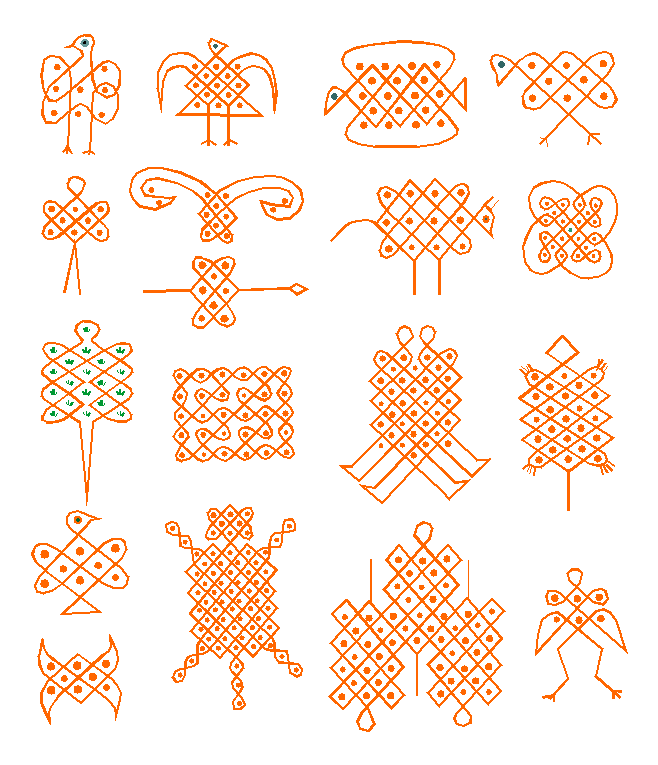
Sona Geometry: Reflections on a drawing tradition of peoples in Africa South of the Equator
Instituto Superior Pedagógico, Maputo, 1994, Vol. 3. 123 pp. (Gerdes, Paulus: Geometria Sona: Reflexões sobre uma tradição de desenho em povos ao Sul do Equador)
The first volume (#109) presented a reconstruction of mathematical elements in the Tchokwe sand drawing (sona) tradition. The second volume (#120) examines the educational and scientific potential of the reconstructed sand drawing tradition. This third volume presents a comparative analysis, studying traditions from other parts of Africa and the world and/or of other periods which are technically similar to the sona tradition.
It contains the following chapters: 9. On geometrical algorithms in ancient Egypt, 10. On monolinear motifs in ancient Mesopotamia, 11. On some geometrical algorithms in India, 12. Short excursion to other continents, and 13. Back to Africa.

Example of a Tchokwe sand drawing

Similar ancient Egyptian pattern
Sona: Sand Drawings of the Tchokwe People
by John Kellermeier
The Tchokwe people inhabit predominantly northeastern Angola and parts of northwestern Zambia and the adjacent areas of southern Congo. They are known for their decorative work including a variety of art and craft and particularly sand drawings known as sona (singular lusona). These sand drawings are part of the oral tradition of the Tchokwe. They serve primarily as a mnemonic device in story telling. Sona are drawn by the men. Boys learn the story telling and sona drawing as part of their initiation rites. Novices are taught by drawing masters called akwa kuta sona.
Sona are usually traceable graphs meaning they can be drawn without lifting the finger or retracing a line. To begin a lusona the artist usually begins by smoothing out the sand and using his fingertips to create a grid of equidistant dots called tobe that serve as a framework for the lusona. The following is the tobe grid and the final drawing of a lusona representing friendship.

Tobe Grid for Friendship Lusona
Many sona depict animals. The following examples are also traceable.
|
A Bat |
An Owl's Head |
A Hyena's Pelt with Spots |
|
A Big Bird |
Not all sona are traceable the following example sona are multilinear in the sense that they are composed of more than one traceable graph. The following lusona represents a Tshihongo mask. It can be broken down into three traceable graphs as illustrated.
|
|
|
|
|
Sona are often used as a memory device for telling a story. The following are two sona and the stories that they represent.
The Hunter and the Dog
|
The two large isolated dots in the lusonarepresent the the dog, Kawa, and the hunter, Tshipinda. The right one is the hunter and the left one is the dog. |
|
|
A hunter Tshipinda borrowed a dog named Kawa from his neighbor, Calala and went on a hunt in which he caught a goat. When he returned to the village, Tshipinda shared the meat with Calala while Kawa was left with the bones. Some time later, Tshipinda again went to Calala and asked to borrow Kawa. However Kawa refused to go saying that Tshipinda should take Calala since that was whom he was used to sharing the meat with. |
|
The Tchokwe Story of the Beginning of the World
|
The figure at the top is God, at the left is the Sun, at the right is the Moon and at the bottom is a human. The lusona represents the path to God.
|
|
|
|
One day the Sun went to visit God. God gave the Sun a chicken and said, "Return in the morning before you leave." In the morning the chicken crowed and woke the Sun. When the Sun went to God, God said, "You did not eat the chicken I gave you for supper. You may keep the chicken but return here every day." That is why the Sun circles the earth and rises every morning. The Moon also went to visit God and was given a chicken. In the morning the chicken crowed and woke the Moon. Again God said, "You did not eat the chicken I gave you for supper. You may keep the chicken but return here every twenty-eight day." That is why the Moon cycle is twenty-eight days long. The human also went to visit God and was given a chicken. But the human was hungry after such a long journey and ate part of the chicken for supper. The next morning the Sun was already high in the sky when the human awoke, ate the rest of the chicken, and hurried to see God. God said, "I did not hear the chicken crow this morning." The human replied fearfully, "I was very hungry and ate it." "That is all right," said God, "but listen: you know that the Sun and Moon have been here, but neither of them killed the chicken I gave them. That is why they themselves will never die. But you killed yours, and so you must die as it did. But at your death you must return here." And so it is. |
References
- Ascher, M. (2002). Mathematics Elsewhere. Princeton, NJ: Princeton University Press.
- Gerdes, P. (1990). On Mathematical Elements in the Tchokwe Sona Tradition. For the Learning of Mathematics. 10, 1.
- Gerdes, P. (1993). Exploring Angolan Sand Drawings (sona): Stimulating Cultural Awareness in Mathematics Teachers. Radical Teacher, 43, 18-43.
- Gerdes, P. (2006). Sona Geometry from Angola: Mathematics of an African Tradition. Monza, Italy: Plimetrica International Science Publishers.
- Gerders, P. (2007). Drawings from Angola: Living Mathematics, Morrisville, NC: Lulu.com.
- Zaslavsky, C. (1973). Africa Counts, 172-189, Boston: Prindle, Weber & Schmidt.
©2010 John Kellermeier
FFSA
Mangovo Ngoyo
.
.

